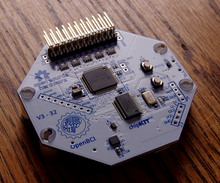OpenBCI: Difference between revisions
m→Software:"being developed" --> "available" |
→Applications:wikify EP |
||
| Line 20: | Line 20: | ||
== Applications == |
== Applications == |
||
The OpenBCI has been used to control a HexBug robot using [[SSVEP]]s (Steady State Visually Evoked Potentials).<ref>{{Cite news|url = http://neurogadget.com/2014/08/31/early-openbci-researcher-hacks-hex-bug-gives-advice-brain-hackers/10530|title = Early Openbci Researcher Hacks a Hexbug and Gives Advice to Other Brain-hackers|last = Pate|first = Josh|date = 2014-08-31|work = Neurogadget|access-date = 2015-01-09}}</ref> [[Locked in syndrome|Locked in]] graffiti artist [[Tempt One]] has used the OpenBCI and the low-cost [[EyeWriter|Eyewriter]] eye-tracking system to continue to draw after being diagnosed with the degenerative nerve disorder [[ALS]].<ref>{{Cite news|url = http://neurogadget.com/2014/09/16/brainwriter-helps-graffiti-artist-suffering-als-draw-using-openbci/10560|title = Brainwriter Helps Graffiti Artist Suffering from ALS to Draw Using Openbci|last = Pate|first = Josh|date = 2014-09-16|work = Neurogadget|access-date = 2015-01-09}}</ref> |
The OpenBCI has been used to control a HexBug robot using [[SSVEP]]s (Steady State Visually[[Evoked potential|Evoked Potentials]]).<ref>{{Cite news|url = http://neurogadget.com/2014/08/31/early-openbci-researcher-hacks-hex-bug-gives-advice-brain-hackers/10530|title = Early Openbci Researcher Hacks a Hexbug and Gives Advice to Other Brain-hackers|last = Pate|first = Josh|date = 2014-08-31|work = Neurogadget|access-date = 2015-01-09}}</ref> [[Locked in syndrome|Locked in]] graffiti artist [[Tempt One]] has used the OpenBCI and the low-cost [[EyeWriter|Eyewriter]] eye-tracking system to continue to draw after being diagnosed with the degenerative nerve disorder [[ALS]].<ref>{{Cite news|url = http://neurogadget.com/2014/09/16/brainwriter-helps-graffiti-artist-suffering-als-draw-using-openbci/10560|title = Brainwriter Helps Graffiti Artist Suffering from ALS to Draw Using Openbci|last = Pate|first = Josh|date = 2014-09-16|work = Neurogadget|access-date = 2015-01-09}}</ref> |
||
==See also== |
==See also== |
||
Revision as of 11:06, 22 September 2020

OpenBCIis anopen-sourcebrain-computer interfaceplatform,[1]created by Joel Murphy andConor Russomanno,after a successful Kickstarter campaign in late 2013.
OpenBCI boards can be used to measure and record electrical activity produced by the brain (EEG), muscles (EMG), and heart (EKG), and is compatible with standard EEG electrodes. The OpenBCI boards can be used with the open source OpenBCI GUI, or they can be integrated with other open-source EEG signal processing tools.
Hardware
The OpenBCI 32bit Board uses the ADS1299, anICdeveloped byTexas Instrumentsfor biopotential measurements.[2]The OpenBCI uses amicrocontrollerfor on-board processing — the 8bit version (now deprecated) uses anArduino-compatible ATmega328P IC, while the 32bit board uses aPICmicrocontroller — and can write the EEG data to an SD card, or transmit it to software on a computer over abluetoothlink.
In 2015, OpenBCI announced the Ganglion board with a 2nd Kickstarter campaign. It costs $200 and has 4 input channels for measuring EEG, EMG, and EKG, and is also Bluetooth enabled.
Software

OpenBCI has released an open-source application for use with the OpenBCI, written withProcessing.Display and processing software written inNodeJSandPythonare also available.
3D Printed Headset

Design files for a3D printedheadset for pre-production OpenBCI boards have been released on GitHub. The headset, known as the Ultracortex, holds the electrodes in place, and makes it easy to configure their placement using the10–20 System.A headset design files are available for download from OpenBCI's Github account, or the headset can be purchased from the OpenBCI online store. The headsets are manufactured and produced by Voodoo Manufacturing.
Applications
The OpenBCI has been used to control a HexBug robot usingSSVEPs(Steady State VisuallyEvoked Potentials).[3]Locked ingraffiti artistTempt Onehas used the OpenBCI and the low-costEyewritereye-tracking system to continue to draw after being diagnosed with the degenerative nerve disorderALS.[4]
See also
References
- ^OpenBCI official page
- ^Cohen, Reuven (2014-03-01)."New Open Source Platform Allows Anyone To Hack Brain Waves".Forbes.Forbes Media.Retrieved2014-12-16.
- ^Pate, Josh (2014-08-31)."Early Openbci Researcher Hacks a Hexbug and Gives Advice to Other Brain-hackers".Neurogadget.Retrieved2015-01-09.
- ^Pate, Josh (2014-09-16)."Brainwriter Helps Graffiti Artist Suffering from ALS to Draw Using Openbci".Neurogadget.Retrieved2015-01-09.
